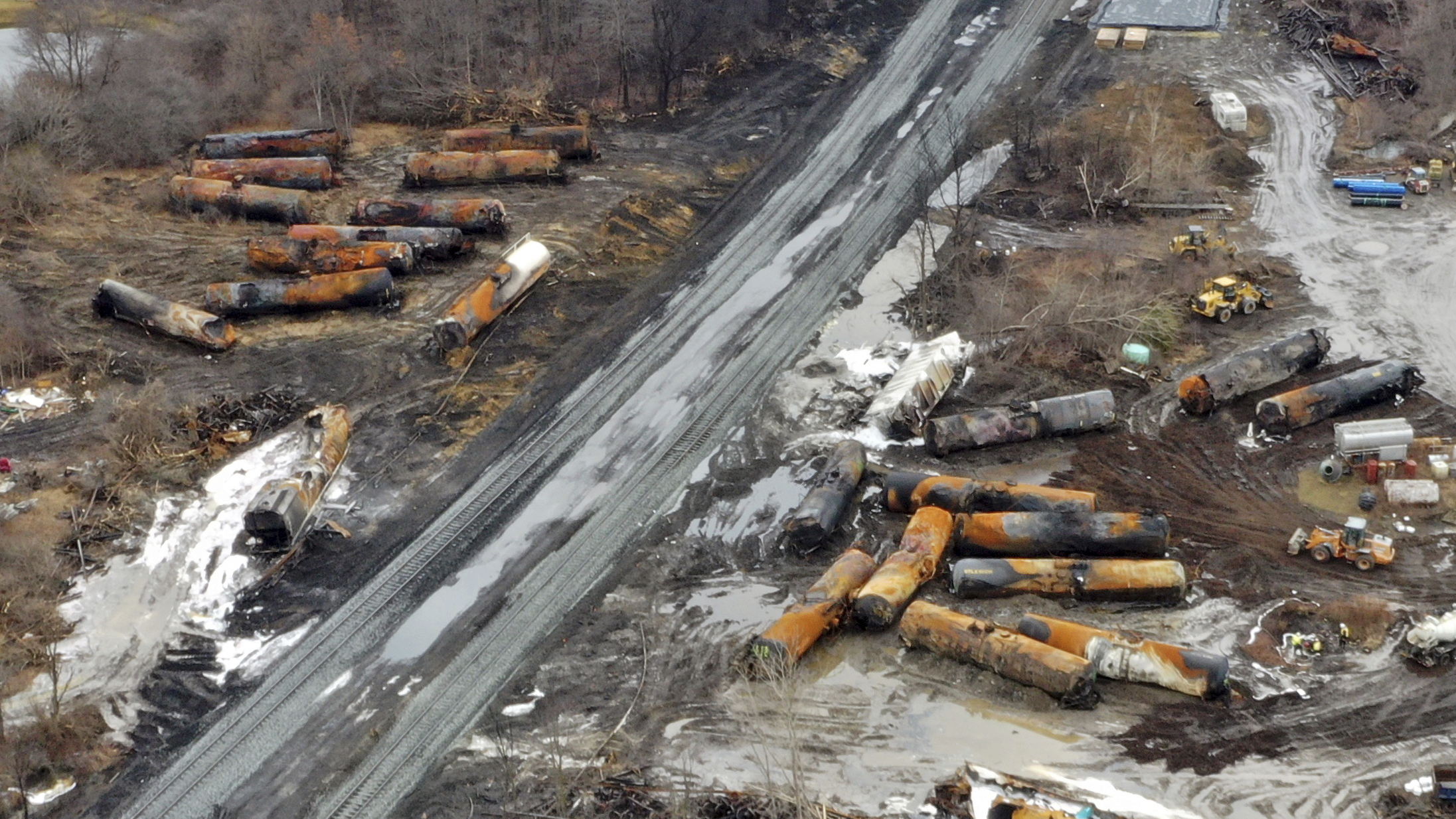
Ominous images of an ominous black cloud covering the skies over Eastern Palestine, Ohio, flooded social media after a train loaded with toxic materials was derailed earlier this month.
The train, which caught fire after 50 of its 150 cars were derailed, was carrying hazardous materials in some of the cars, such as chlorethene, a colorless gas used in PVC plastics.
“Controlled” releases
are a strange kind of corporate duplicity. This will harm millions of people in Ohio/Pennsylvania for years to come. But hey – at least @nscorp made a $10 billion share buyback to pump up their shares instead of upgrading
brakes. #OhioChernobyl pic.twitter.com/hdCPU6BQSN
— Eric Feigl-Ding (@DrEricDing) February 14, 2023
Both this chemical compound and other flammable chemicals carried on the train, such as 2-butoxyethanol, 2-ethylhexyl acrylate, butyl acrylate, methylpropene, were released into the environment after the derailment.
Many of these chemicals are carcinogenic or potentially carcinogenic and are considered harmful to the eyes and respiratory system.

The toxicity of these chemicals initially raised concerns for the health and safety of the inhabitants of the wider area. But then, due to the intensity of the phenomenon, comparisons also arose with one of the worst nuclear disasters that humanity experienced about four decades ago, with the Chernobyl disaster.
This is Chernobyl Ohio. pic.twitter.com/NoPRWiWvoy
— Stew Peters (@realstewpeters) February 13, 2023
Thus, there are many who express fear that because of this accident Ohio will become the new Chernobyl.
Although dramatic footage from the area may suggest that this is indeed a mini-Chernobyl, experts assure that the scale of that catastrophe was incomparably greater, while emphasizing that the environmental impact of the accident should by no means be ignored. .
Ohio’s chemicals are carcinogenic, Chernobyl’s are radioactive.
The Chernobyl accident occurred when safety measures were ignored during a nuclear reactor test. The ensuing horrific explosion scattered massive amounts of radioactive chemicals, including plutonium, iodine, strontium, and cesium.
Numerous controlled small explosions that occurred after a train derailed in Eastern Palestine ignited many of the carcinogenic chemicals being transported, creating a huge black cloud that has hung over the city ever since.
If even one sea turtle in California choked on a plastic straw, we would be bombarded with exaggerated headlines for weeks.
Yet *real people* have been breathing this gigantic plume of toxic PVC for over a week in Ohio and… almost no news coverage? #OhioChernobyl pic.twitter.com/yu2ZPhdxq8
— Kristen Mag (@kristenmag) February 13, 2023
These chemicals in Ohio may be carcinogenic, but in Chernobyl they were radioactive. And what’s more, people in the know say it’s not as powerful as Chernobyl’s nuclear waste.
In an accident in Ohio and a derailment and a chemical spill there were no dead, according to local authorities. However, some citizens showed respiratory problems, sore throats, eye irritation and headaches.
On the other hand, at Chernobyl, two people died immediately after the explosion, thirty workers a month later due to the radiation they received, and thousands more in subsequent years from cancer and blood diseases due to exposure to chemicals.
JUST IN: “It’s not thunderclouds,” says a local resident after an environmental disaster in East Palestine, Ohio – the video was filmed in Darlington, Pennsylvania. #OhioChernobyl pic.twitter.com/tu7X2jOLtl
— Upward News (@UpwardNewsHQ) February 14, 2023
Animal death
There have been reports of a significant number of animals dying as a result of the controlled burning of chemicals to prevent a major explosion.
There were many dead pets in the area’s four canals, as well as foxes, chickens and over 3,500 dead fish, residents said.
On the other hand, the influence of Chernobyl on the fauna of the region has not been precisely established. According to the International Atomic Energy Agency (IAEA), the explosion had a direct impact on the health of animal populations, and many plants and animals were mutated by exposure to radiation.

After the crash, authorities ordered the city to be evacuated, with about 2,000 residents being evacuated. However, less than 24 hours later, local authorities announced that citizens could safely return to their homes, as the Ministry of the Environment found no “alarming levels” of pollutants in the area’s water and air. Since then, the competent local agency has controlled the land with controls for fear of groundwater contamination.
Several days of evacuation in Ohio, Chernobyl uninhabitable
In the dramatic case of Chernobyl, an explosion contaminated a vast area of 150,000 square meters. km in Belarus, Ukraine, Russia, causing the forced flight of 350,000 people who died in an instant and forever. An exclusion zone with a radius of 30 km was established around nuclear facilities and is still in effect today.
During the war in Ukraine, Russian soldiers returned to Chernobyl by digging trenches around it. According to the State Nuclear Service of Ukraine, the Russians received “significant doses of radiation” and soon left the site.
Source: Business Insider
Source: Kathimerini
Anna White is a journalist at 247 News Reel, where she writes on world news and current events. She is known for her insightful analysis and compelling storytelling. Anna’s articles have been widely read and shared, earning her a reputation as a talented and respected journalist. She delivers in-depth and accurate understanding of the world’s most pressing issues.